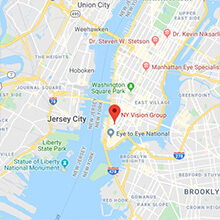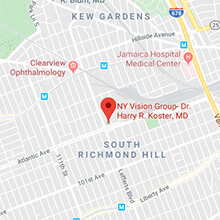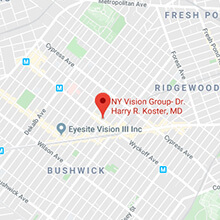 Each year many people lose vision due to progressive diseases or conditions of the eye. Often there are no symptoms indicating something is wrong, or vision loss occurs so gradually that it is not readily noticeable to a patient. Consequently, it is important to regularly schedule a comprehensive eye exam with an experienced, knowledgeable eye group such as the NY Vision Group.
Each year many people lose vision due to progressive diseases or conditions of the eye. Often there are no symptoms indicating something is wrong, or vision loss occurs so gradually that it is not readily noticeable to a patient. Consequently, it is important to regularly schedule a comprehensive eye exam with an experienced, knowledgeable eye group such as the NY Vision Group.
As a general rule, persons under 40 should have an eye examination every two years unless there are obvious diseases or adverse conditions that would necessitate additional examinations. Individuals over the age of 40 face an increased risk of certain serious eye conditions and diseases; thus an eye exam every year is recommended for people over 40.
At NY Vision Group we perform thorough eye exams utilizing the latest technology to safeguard your vision. We check for common vision disorders such as myopia, hyperopia, astigmatism, presbyopia, and dry eye syndrome, and also perform expert contact lens fittings. We evaluate and monitor for glaucoma with the latest imaging devices of the eye’s internal structure (using the optical coherence tomography, or OCT III, system) which allows us to detect the earliest signs of glaucoma and also set a baseline for future evaluations. NY Vision Group also performs diabetic eye exams and a variety of in-office procedures such as Selective Laser Trabeculoplasty (SLTs) and Laser Peripheral Iridotomy (LPIs).
Good vision is also key to a child’s development and overall well-being. At NY Vision Group, in Manhattan and Richmond Hill, we provide pediatric eye care for children over the age of 4, although we will see a child of any age in the case of an eye emergency. We test visual acuity with either a standard eye chart or the Nidek autorefractor which gives us a highly accurate reading of the child’s refraction and does not require a young child to decipher symbols on a chart. We also monitor for the possibility of common eye conditions such as amblyopia (lazy eye) and strabismus (crossed eyes) and treat common pediatric eye disorders such as conjunctivitis (pink eye).
Vision is more easily compromised for people over the age of 40 as there is an increased risk of certain eye diseases and conditions as the eye ages: these conditions include cataracts, glaucoma, dry eyes, and macular generation. At NY Vision Group in Manhattan, Richmond Hill, and Brooklyn we diagnose and treat all these conditions.
News in Comprehensive Eye Care: More Daylight/Outdoor Time May Help Nearsightedness
 Two new studies indicate that spending time outdoors may reduce or prevent nearsightedness in children, according to research published in the May 2013 issue of Ophthalmology, the journal of the American Academy of Ophthalmology and described in Ophthalmology Times.[1].
Two new studies indicate that spending time outdoors may reduce or prevent nearsightedness in children, according to research published in the May 2013 issue of Ophthalmology, the journal of the American Academy of Ophthalmology and described in Ophthalmology Times.[1].
In one of the studies that were conducted in Taiwan, children who spent recess time outdoors had a reduced risk of nearsightedness. In this study, an elementary school required its 333 children to spend recess outdoors for a year from 2009-2010. A nearby school did not require school recess.
Students at both schools received eye exams at both the beginning of the study and one year later. The results showed that significantly fewer children became nearsighted (or shifted toward it) in the school that required outdoor recess. The researchers recommend that elementary schools in Asia and other regions add frequent outdoor recess breaks to help protect children’s vision.
In a second, separate study conducted in 2005, 235 Danish schoolchildren who suffered from nearsightedness (myopia) were evaluated and split into seven groups based on their access to daylight. Because daylight hours fluctuate markedly with the season in Denmark (from 7 hours in winter to nearly 18 hours in summer), access to daylight was distinct for each group. Each child’s axial eye length was measured at the beginning and end of each seasonal interval because the elongation of the eye indicates that myopia is worsening. In the children with access to the fewest hours of daylight, eye growth was significantly greater than those children with the most access to daylight.
“Our results indicate that exposure to daylight helps protect children from myopia,” said Dongmei Cui, M.D., Ph.D. of Sun Yat-sen University, China, the leader of the study.
Nearsightedness in childhood is correctable but is linked to the development of more severe forms of this disorder in adulthood, which can increase the risk for serious eye diseases such as glaucoma and retinal detachment. Research in nearsightedness is increasing as the number of people with the condition reaches epidemic status in Asia and other developed countries. Though myopia is often inherited, researchers are also investigating environmental factors to try to determine why myopia is increasing so rapidly in some populations.[2]
[1]Studies’ summary courtesy of Ophthalmology Times, May 22, 2013; [2]High heritability of myopia does not preclude rapid changes in prevalence. Clin Experiment Ophthalmol 2002;30:168 –72.
Dr. Koster Comments on New Study:
 Dr. Koster notes that while exposure to daylight may protect children from myopia, it is important for kids and adults to wear the appropriate protective gear, particularly during the summer months, when the sun’s ultraviolet rays are at their strongest. He notes that overexposure to these rays can burn people’s corneas and even cause painful temporary blindness as well as contribute to longer-term vision problems.
Dr. Koster notes that while exposure to daylight may protect children from myopia, it is important for kids and adults to wear the appropriate protective gear, particularly during the summer months, when the sun’s ultraviolet rays are at their strongest. He notes that overexposure to these rays can burn people’s corneas and even cause painful temporary blindness as well as contribute to longer-term vision problems.
Several scientific studies* indicate that years of exposure to the sun without eye protection can seriously damage a person’s eye, potentially contributing to cataracts and macular degeneration. A lesser-known, but more immediate, the risk is that of sunburnt eyes. People with light-colored eyes are more at risk for this condition.
A mild case of sunburnt eyes feels like grit stuck in the eyes. Patients with extreme cases describe the feeling of having their eyeballs on fire! Patients who experience such severe symptoms should immediately see an eye doctor, such as the experienced doctors at NY Vision Group.
The typical treatment is cool wet compresses and artificial tears. Anti-inflammatory drops can also be used to reduce swelling and eye pain, and affected patients should try to stay out of the light, remove contact lenses if they wear them and avoid rubbing eyes.
“It’s really important for people to remember to wear their sunglasses during the summer, even if it is cloudy, ” says Dr. Harry Koster, Medical Director of NY Vision Group. “Maybe a little redness from sunburn on the arm doesn’t seem like a big deal, but the skin of your cornea is extremely thin and is far more sensitive.”
*As cited in the AAO’s 6/03/13 release, “Overexposure to Sun’s Rays Can Cause Painful, Temporary Blindness.”




